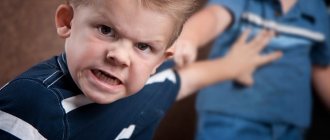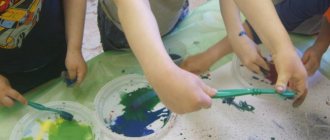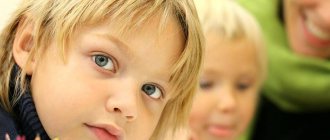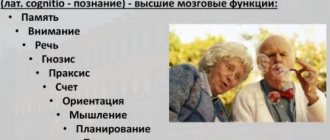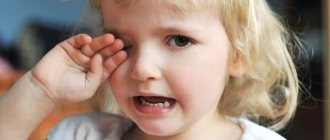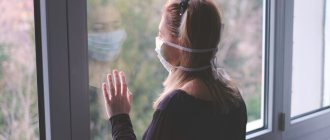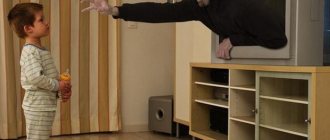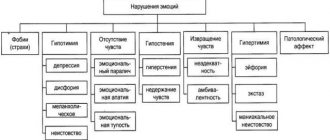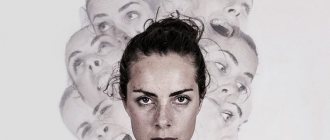Title: “Children's fears. Diagnostics and correction " - presentation. Author: Adelina Sagitova Year: 2012 Format: presentation in ppt format, (rar archive). Number of slides: 21 Size: 3.13 MB Quality: good
Fear is an emotion that arises in situations of threat to the biological or social existence of an individual and is aimed at the source of real or imagined danger.
Children's fears, if we treat them correctly and understand the reasons for their appearance, most often disappear without a trace. If they are painfully sharpened or persist for a long time, then this is a sign of trouble, indicating the physical and nervous weakness of the child, improper parental behavior, and conflicting relationships in the family.
Theories of fear
I.P. Pavlov considered fear to be a manifestation of a natural reflex, a passive defensive reaction with slight inhibition of the cerebral cortex. Fear is based on the instinct of self-preservation, has a protective nature and is accompanied by certain changes in higher nervous activity, reflected in the pulse and respiration rates, blood pressure, and the secretion of gastric juice. In its most general form, the emotion of fear arises in response to a threatening stimulus.
Causes of fear
Causes of fear (common): - specific case (bitten by a dog, stuck in an elevator) - inspired fears - childhood fantasy - intrafamily conflicts - relationships with peers - neurosis
The question of the reasons remains open today as follows:
Z. Freud identifies 2 sources: 1) automatic (in situations of danger); 2) produced – events that contribute to failures. E. Fromm: 4 situations that cause fear and anxiety: imitation, trauma, punishment system, guilt.
In Russian psychology (Danilova, Garbuzov, Krishakova), the cause of children's fears and anxiety is considered to be the peculiarities of upbringing: hypersocialized (over-orientation towards others); non-acceptance of the child by the mother; anxious – suspicious upbringing; egocentric (child is a star).
Where do children's fears come from? What to do with them? Advice from psychologist Igor Romanets.
Dynamics of fears and anxiety
1. Pregnancy, childbirth: the fetus reacts to the mother’s state of anxiety. 2. First months: lack of contact, bright light, sharp sounds. 3. 1-3 years - nightmares (wolf, Baba Yaga). 5. 5–7 years - fear of death, fear of war, natural disaster. 6. 7 - 11 years - social fears, for example, fear of deuces. 7. 11 - 15 years - increased anxiety about changes in appearance, obsessive fears, for example, fear of not being the best, fear of rejection.
Criteria for identifying anxiety in a child:
1. Feels constant anxiety. 2. Difficulty concentrating. 3. Muscular tension is more common in the face and neck. 4. Irritability. 5. Sleep disturbance. If 2-3 criteria are present, then the child is anxious.
Mosaic of life
Tweet
Diagnosis of children's fears
– this is an indispensable stage from which their correction and overcoming will begin.
This stage is all the more important because, as a rule, children do not talk about their fears, especially for preschoolers and primary schoolchildren. Therefore, in this article we will focus on diagnostic methods specifically for young children (in general, these methods, of course, depend on age).
So, if you notice deviations in behavior in a child, such as restless sleep, nervousness, new habits (biting nails, twirling hair on a finger, etc.), quirks and unreasonable whims, then you need to look for the reasons for such phenomena.
Diagnosis of children's fears
in young children it can be done using
drawings
. Here the choice of options is very diverse: you can ask to draw just a picture on an arbitrary topic, you can designate a topic (family, school, kindergarten, friends, my fears...)
The method of deciphering children's drawings is not the purpose of this article, because the format of one article is not enough to reveal all the nuances. If desired, every parent will find many sources of information on this issue.
Here I would like to note a few points that parents should definitely pay attention to in their children’s drawings:
- drawings on hopeless, catastrophic themes with an abundance of scary monsters should attract the attention of parents;
- if a child depicts himself always standing alone, apart from other people in the picture, this is a clear sign of problems with communication, fear of making contact, fear of loneliness;
- if a child draws practically nothing or does it reluctantly, this is also a signal that the child is not all right;
- thick, black lines, made with great pressure, perforating a sheet of paper - a signal that the child is trying to get rid of something, cross it out, throw it out of his life;
- a passion for black, gray and brown colors should also alert you, because it indicates pessimism and a depressed state.
Diagnosis of children's fears actively uses the test method
. To diagnose children of preschool and primary school age, tests are usually used, the questions of which are answered by parents. Tests can be to identify anxiety or determine the level of self-esteem, tests about certain types of fears: fear of loss, fear of new relationships, dangerous phenomena or animals, etc.
Diagnosing children's fears, of course, cannot be done without observation methods.
English psychologist John Bowlby talks about so-called “fear beacons” that will help separate fear from other emotions. For example, we can say with great accuracy that a child is afraid if he stares intensely at some object (object), frozen for several seconds with fear on his face. And then the baby looks for one of the adults to receive support and protection. An absent look, a desire to shrink, to close down – these are also “beacons”. A frightened child's palms become damp, the skin of his face turns pale, and his breathing becomes rapid and intermittent.
Parents should be wary if their child has a penchant for aggressive entertainment - he raves about weapons, constantly plays war games, and shoots toys with gusto and pleasure. Such inclinations speak of an internal feeling of insecurity and fear of attack, fear of death. If a child has the habit of breaking toys, tearing off parts of their “body” - this also indicates the presence of a certain kind of fear - fear of illness, fear of injections and doctors.
A very dangerous symptom is the child’s desire to hurt living beings - animals, younger brothers and sisters.
Childhood ailments (nausea, headache, abdominal pain, etc.) before any event (test, exam, unpleasant trip, doctor's visit) are also a direct manifestation of fear, which is revealed by observation.
I suggest you conduct a rapid diagnosis by monitoring the child for 3-5 days.
On a piece of paper, write down the manifestations of anxiety and mark, for example, with a tick or a cross if you have observed such a manifestation in a child:
- restlessness, nervousness throughout the day;
- facial convulsions, tension in the muscles of the face and neck;
- problems sleeping or falling asleep;
- problems with concentration and concentration;
- capriciousness and tearfulness.
If you notice at least one of the listed manifestations of anxiety in a child, it is necessary to conduct a more thorough diagnosis.
Diagnosis of childhood fears in young children can be carried out using special fairy tales and stories
. For example, as suggested by I.V. Samoilenko:
Fairy tale "Little Squirrel ". In the hollow of one large and tall tree there lived a squirrel family: father, mother and little squirrel son. One day a strong, strong wind blew and the entire squirrel family fell out of the hollow. Dad, in flight, grabbed a strong branch with his strong paws and climbed up the tree. Mom deftly caught onto a branch with her fluffy tail. And only the little squirrel rolled down to the ground.
Question: what happened to the baby squirrel?
Children's responses corresponding to the norm will be of the following nature:
— he also climbed the tree;
— he was scared, but quickly climbed up to his mother;
- he was scared, but quickly climbed up to his dad;
— the little squirrel called his mom and dad for help, and they helped him climb the tree again.
Answers that should alert you:
— the little squirrel hit the ground and died;
- the little squirrel was left alone on the ground and died of cold (hunger);
- everyone forgot about the little squirrel;
- the baby squirrel was dragged away by wolves (fox, bear...);
— the little squirrel remained on the ground, because he was still small and weak.
The answers show what kind of relationship the child has with his parents, what the child fears, what he lacks in the family.
You can come up with some similar story yourself and talk to your child about it.
Diagnosis of children's fears can also be carried out by asking specific questions:
Are you afraid to sleep alone in a room?
Do you have scary dreams?
Are you afraid to ride the elevator?
Fly on a plane?
Are you afraid of Baba Yaga? etc.
Attentive and sensitive parents will always be able to notice an anxious state in a child, and timely diagnosis of children's fears will help to cope with them without upsetting consequences.
Interesting article? Please share it with others:
Tweet
Like
Related posts:
Developing leadership qualities in a child
Clean air in the kitchen: choosing an air purifier...
How often do you run out of time...
Vinegar: familiar and not so familiar
Category: Home, family, children
Tags: Diagnosis of children's fears
Types of fears
There are three types of fears. The classification is based on the subject of fear, the characteristics of its course, duration, strength and causes of occurrence.
Obsessive fears - the child experiences these fears in certain, specific situations; he is afraid of the circumstances that may entail them. Such fears include, for example, fear of heights, closed and open spaces, etc.
Delusional fears are the most severe form of fears, the cause of which cannot be found. For example, why is a child afraid to play with some toy or does not want to put on some clothes. Their presence often indicates serious deviations in the baby’s psyche.
Overvalued fears are the most common type. They are associated with fixed ideas and caused by the child’s own imagination. In 90% of cases, practicing psychologists encounter precisely them. At first, these fears correspond to some life situation, and then they become so significant that the child cannot think about anything else.
Overcoming childhood fears
The correctional work of a psychologist is carried out in several directions: - counseling; — lectures and seminars (for parents, teachers); — poster material for parents and information leaflets for teachers.
Work on correcting fears takes place in several stages: Stage 1 – acceptance of applications by a psychologist from parents or educators to diagnose fears in a child. Stage 2 – the psychologist works with children and their parents based on appropriate techniques. Stage 3 – discussion of the child’s diagnostic results with the teacher and parents. At this stage, ways of working together to solve the identified problems are outlined.
Stage 4 – conducting correctional classes with the child. Stage 5 – re-diagnosis of the child’s fears, the results of which are also discussed with the teacher and parents.
Three main directions in correctional work with anxious children: 1. Increasing self-esteem (exercise “Praises”, “Why Mom Loves Me”). 2. Training in ways to relieve emotional and muscle tension (sand techniques, drawing and sculpting, massage). 3. Practicing self-control skills in traumatic situations (role-playing games: fear and anxiety should be brought to the point of absurdity, the child should receive the roles of strong personalities, the roles of heroes overcoming difficulties).
Play therapy. Most effective when working with children 4-7 years old. Goals: respond emotionally to tension; role modeling of problem solving. The game allows you to experience life’s circumstances in a conditional, weakened form; strengthen self-confidence. A) outdoor games are used, where the child’s activity, independence, and initiative are demonstrated. b) imitation games, when the child chooses a role that compensates for his capabilities; allow you to develop skills in managing emotions and making decisions. c) dramatization games help overcome fear resulting from fright.
Art therapy . Effective at the age of 5-11 years, when children have no barriers, they draw naturally and spontaneously. Goals: to give vent to feelings, to restructure the attitude towards traumatic situations. Directed drawing is used: 1) the child draws his fear; 2) the child draws his fear and next to himself, not afraid of fear; 3) the child independently destroys his drawing.
Diagnosis of fears:
Ch. Spielberger's method, Phillips school anxiety test, Temple anxiety test, Dorkey, projective techniques.
Fear concept
The concept of fear has been developed by many researchers and therefore has different interpretations.
The issue of childhood fear has a long history in psychological science. S. Hall, as a representative of the biogenetic trend, extended the biogenetic law to the ontogeny of fear. He stated that the child experiences, during his development, the fears that animals, and then people, experienced at different stages of anthropogenesis.
A detailed study of the phenomenon of fear in childhood was carried out within the boundaries of psychoanalysis. 3. Freud believed that fear is an affect that appears in a subjective situation of displeasure, which (displeasure) cannot be dealt with by discharge through the pleasure principle. This situation is caused by a dangerous situation, and fear can be both its direct result and an anticipation of its possible repetition
Definition 1
Fear is an internal state caused by a threatening real or perceived disaster. From a psychological point of view, it is considered a negatively colored process in the emotional sphere.
Finished works on a similar topic
- Course work Diagnosis of children's fears 420 rub.
- Abstract Diagnosis of children's fears 240 rub.
- Test work Diagnosis of children's fears 230 rub.
Receive completed work or specialist advice on your educational project Find out the cost
Definition 2
Children's fears are children's emotional reactions to a situation of threat (imaginary or real) or to an object that is dangerous in children's understanding, which they experience as discomfort, a desire to hide or run away.
The primary emotion of fear is already observed in newborn children. Afterwards, fears are socialized and appear as reactions to new situations and objects. The consolidation of primary fear in the emotional sphere of children expands the zone of their social fears and increases sensitivity to carriers of the threat. Children's fears are formed due to a lack of warmth and acceptance from parents, when children do not feel safe. Such children often develop a fear of school. Children's fears can be expressed in neurotic reactions and psychosomatic disorders.
Children's fears are caused by age-related developmental characteristics and are temporary. Understanding the reasons for the formation of children's fears helps to resolve them.
Too lazy to read?
Ask a question to the experts and get an answer within 15 minutes!
Ask a Question


